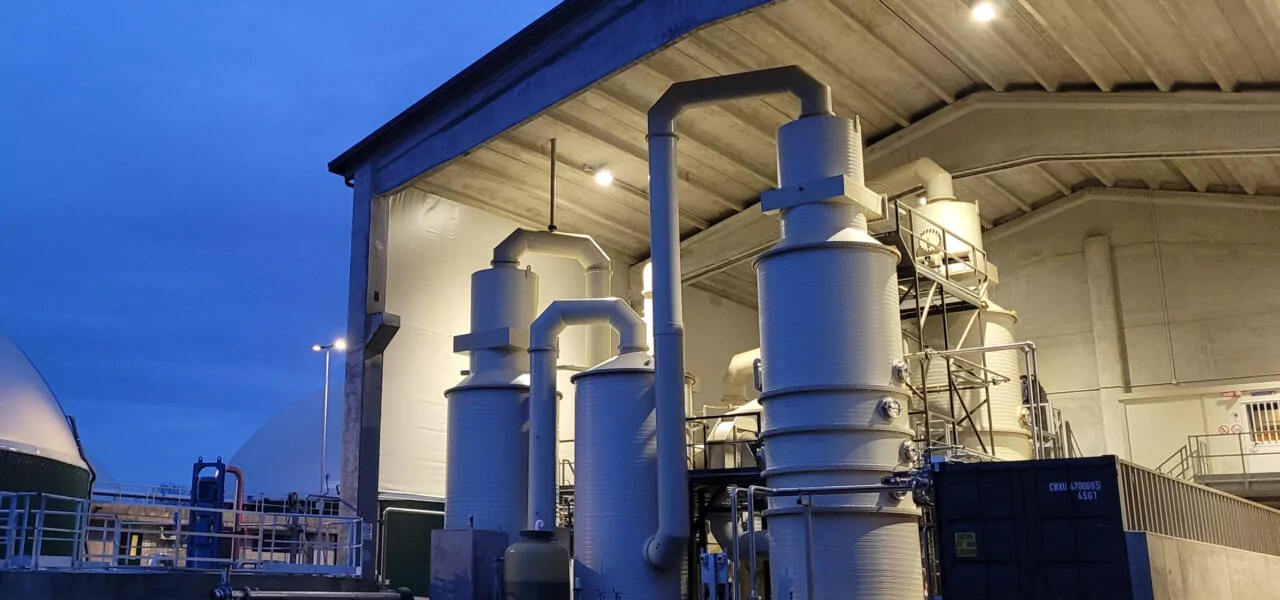Let’s dive into the solutions, part of the Nijhuis Saur Industries portfolio, for digestate treatment, pasteurization, water reuse and nutrient recovery.
Ammonia stripping and digestate treatment
Ammonia stripping plays a central role in modern digestate treatment. Ammonia stripper technology (e.g. ByoFlex®) removes and recovers high concentrations of ammonia nitrogen from liquid digestate through a controlled thermal and air-stripping process.
There are multiple challenges which can be tackled with ammonia stripping, such as the reuse of water as ‘dilution water’ for the anaerobic digestion to reduce fresh water usage. Or, to land spread the liquid fraction of digestate with a reduction amount of nitrogen. Or, when very strict nitrogen discharge limits must be met, integrating the ammonia stripping before digestate enters the nitrification/denitrification biological treatment stage, can dramatically reduce the size of the biological tank, and so reduce the capital and operational expenditure.
is In general, ammonia stripping not only reduces ammonia emissions and treatment costs but also helps biogas operators transform a challenging by-product into a resource stream. The result: cleaner effluent, higher regulatory compliance, and measurable circular value.
Pasteurization of digestate
Pasteurization can be a necessary step in order to spread digestate on the agricultural fields. Or, pasteurization can be needed to heat up a waste stream as feedstock for a biogas plant or when digestate must be exported. The necessary heat for the pasteurization (e.g. ByoPast®) process is usually eligible for a heat bonus or can be recovered. With the pasteurization technology, manure, digestate or other substrates can be pasteurized according to the EEU standards 1069/2009 or BS-PAS-110.
Aerobic treatment for stable and clean effluent
While anaerobic digestion generates renewable biogas, the remaining liquid fraction often requires additional polishing. Through aerobic post-treatment systems (e.g. BIOCTOR), digestate can be stabilized and organic loads significantly reduced.
These aerobic processes — often integrated with MBBR, activated sludge, or membrane bioreactor configurations — ensure reliable performance under variable conditions. The outcome is a stable effluent that meets discharge or reuse standards, enabling biogas plants to operate more efficiently and sustainably.
Dissolved air flotation (DAF) and solid removal
A crucial step in any digestate treatment line is the separation of suspended solids, and fine organic material before biological or membrane treatment. The DAF systems (e.g. i-DAF) provide a robust and efficient solution for this stage.
By injecting microbubbles that attach to suspended particles, the DAF unit separates solids from the liquid phase, reducing downstream fouling and improving overall process stability. In digestate treatment, this means better nutrient recovery, higher system reliability, and reduced maintenance costs.
(Titanium) membrane systems – concentration of nutrients and maximizing water reuse for difficult to treat streams
For advanced polishing and water recovery, multistage membrane steps in titanium (e.g. DEEPEST®) , microfiltration, nanofiltration, and reverse osmosis , can treat even the most complex digestate or effluent streams.
With recovery rates exceeding 90 %, the solution enables facilities to reclaim clean water for reuse while concentrating valuable nutrients in separate fractions. This technology exemplifies commitment to closing the water loop and maximizing resource efficiency within the waste-to-energy sector.
Also other more ‘standard’ membrane solutions like UF units act as a physical barrier that removes suspended solids, colloids, and bacteria, providing a stable pre-treatment step before RO. The RO membranes then produce high-quality permeate with extremely low concentrations of dissolved salts and nutrients, enabling direct water reuse within the facility.
Together, UF and RO provide a proven and modular approach to achieving consistent effluent quality.
Biogas treatment with desulfurization technologies
Effective plant performance requires attention not only to digestate treatment, but also to the purification of biogas. Desulphurization technologies (e.g. Econvert-Dsulph) efficiently remove hydrogen sulfide (H₂S) and other unwanted gases from raw biogas, protecting downstream equipment and ensuring a higher, more stable methane quality.
By integrating desulfurization into the overall biogas treatment process, operators can improve biogas purity, extend equipment lifespan, and achieve higher energy yields — turning gas into a clean, renewable energy source when injecting it into the grid. And finally, improving the TCO as the technology consumes no chemicals.
Conclusion – it’s the combination that makes the perfect blend
While stand-alone systems can often lead to quick process improvements, it’s the smart combination of e.g. stripping, flotation, biological polishing, membrane filtration, and gas treatment technologies, which provides a complete and modular toolbox for digestate and biogas management. These systems not only help clients meet environmental standards but also enable them to reduce, remove, reuse, and recover.
As regulations tighten and environmental expectations rise, the ability to recover resources efficiently is becoming a decisive factor for plant performance and competitiveness. In our next blog, we share specific solutions we provided for local project challenges.
Nijhuis Saur Industries brings integrated solutions to address these technological barriers. With decades of expertise in wastewater, biogas, and resource recovery, NSI delivers complete solutions that combine digestate treatment, water reuse, and biogas purification in one plant.
📢 Join our LIVE WEBINAR: "A new dawn in digestate treatment for waste-to-energy"
📅 November 18th | 15:00-15.25 CET
Join the NSI Academy to learn from real projects how the right solutions were selected to overcome local challenges.
🔗 Reserve your spot today: https://register.gotowebinar.com/register/3756402762022998624
